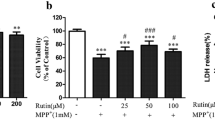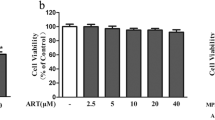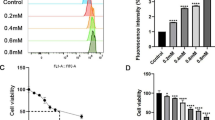Abstract
Hydrogen sulfide (H2S), an endogenously produced gas, is a cardioprotective agent against neurotoxin-induced neurodegeneration in Parkinson's disease (PD). However, the roles of H2S in 1-methyl-4-phenylpyridinium ion (MPP+)-treated SH-SY5Y cells with the involvement of reactive oxygen species-nitric oxide (ROS-NO) signaling pathway in PD remain unclear. For this study, a MPP+-treated SH-SY5Y cell model was established to explore the regulatory role of H2S in oxidative stress injury and cell apoptosis. With the cell viability, apoptosis, cytotoxicity, levels of reactive oxygen species (ROS) and nitric oxide (NO), mitochondrial transmembrane potential (Δψm), contents of oxidative stress injury-related markers (glutathione, superoxide dismutase, malondialdehyde), levels of apoptosis-related proteins (Caspase 3, Bax, Bcl-2) and inducible nitric oxide synthase (iNOS) determined, this study demonstrated that NaHS (an H2S donor) treatment could alleviated the reduction of cell viability and cytotoxicity, cell apoptosis, Δψm loss, contents of ROS and NO, and oxidative stress injury induced by MPP+. The present study showed that H2S may protect SH-SY5Y cells from MPP+-induced injury in PD cell model via the inhibition of ROS-NO signaling pathway and provide insight into the potential of H2S for PD therapy.






Similar content being viewed by others
References
Kostek B, Kaszuba K, Zwan P, Robowski P, Slawek J (2012) Automatic assessment of the motor state of the Parkinson's disease patient—a case study. Diagn Pathol 7:18. https://doi.org/10.1186/1746-1596-7-18
Lenka A, Padmakumar C, Pal PK (2017) Treatment of older Parkinson's disease. Int Rev Neurobiol 132:381–405. https://doi.org/10.1016/bs.irn.2017.01.005
Dai D, Wang Y, Zhou X, Tao J, Jiang D, Zhou H, Jiang Y, Pan G, Ru P, Ji H, Li J, Zhang Y, Yin H, Xu M, Duan S (2014) Meta-analyses of seven GIGYF2 polymorphisms with Parkinson's disease. Biomed Rep 2(6):886–892. https://doi.org/10.3892/br.2014.324
Karunanayaka PR, Lee EY, Lewis MM, Sen S, Eslinger PJ, Yang QX, Huang X (2016) Default mode network differences between rigidity- and tremor-predominant Parkinson's disease. Cortex 81:239–250. https://doi.org/10.1016/j.cortex.2016.04.021
Ito K, Eguchi Y, Imagawa Y, Akai S, Mochizuki H, Tsujimoto Y (2017) MPP+ induces necrostatin-1- and ferrostatin-1-sensitive necrotic death of neuronal SH-SY5Y cells. Cell Death Discov 3:17013. https://doi.org/10.1038/cddiscovery.2017.13
Thomas B, Beal MF (2010) Mitochondrial therapies for Parkinson's disease. Mov Disord 25(Suppl 1):S155–160. https://doi.org/10.1002/mds.22781
Korge P, Ping P, Weiss JN (2008) Reactive oxygen species production in energized cardiac mitochondria during hypoxia/reoxygenation: modulation by nitric oxide. Circ Res 103(8):873–880. https://doi.org/10.1161/CIRCRESAHA.108.180869
Yang J, Wu LJ, Tashino S, Onodera S, Ikejima T (2008) Reactive oxygen species and nitric oxide regulate mitochondria-dependent apoptosis and autophagy in evodiamine-treated human cervix carcinoma HeLa cells. Free Radic Res 42(5):492–504. https://doi.org/10.1080/10715760802112791
Luo Y, Hoffer A, Hoffer B, Qi X (2015) Mitochondria: A Therapeutic Target for Parkinson's Disease? Int J Mol Sci 16(9):20704–20730. https://doi.org/10.3390/ijms160920704
Wang R (2014) Gasotransmitters: growing pains and joys. Trends Biochem Sci 39(5):227–232. https://doi.org/10.1016/j.tibs.2014.03.003
Ying R, Wang XQ, Yang Y, Gu ZJ, Mai JT, Qiu Q, Chen YX, Wang JF (2016) Hydrogen sulfide suppresses endoplasmic reticulum stress-induced endothelial-to-mesenchymal transition through Src pathway. Life Sci 144:208–217. https://doi.org/10.1016/j.lfs.2015.11.025
Cao X, Cao L, Ding L, Bian JS (2018) a new hope for a devastating disease: hydrogen sulfide in Parkinson's disease. Mol Neurobiol 55(5):3789–3799. https://doi.org/10.1007/s12035-017-0617-0
Dasuri K, Zhang L, Keller JN (2013) Oxidative stress, neurodegeneration, and the balance of protein degradation and protein synthesis. Free Radic Biol Med 62:170–185. https://doi.org/10.1016/j.freeradbiomed.2012.09.016
Wallace DC (2010) Mitochondrial DNA mutations in disease and aging. Environ Mol Mutagen 51(5):440–450. https://doi.org/10.1002/em.20586
Zuo L, Motherwell MS (2013) The impact of reactive oxygen species and genetic mitochondrial mutations in Parkinson's disease. Gene 532(1):18–23. https://doi.org/10.1016/j.gene.2013.07.085
Kim DH, Li H, Han YE, Jeong JH, Lee HJ, Ryu JH (2018) Modulation of Inducible nitric oxide synthase expression in LPS-stimulated BV-2 Microglia by prenylated chalcones from Cullen corylifolium (L.) Medik. through Inhibition of I-κBα degradation. Molecules 23(1):10000. https://doi.org/10.3390/molecules23010109
Hancock JT, Whiteman M (2016) Hydrogen sulfide signaling: interactions with nitric oxide and reactive oxygen species. Ann N Y Acad Sci 1365(1):5–14. https://doi.org/10.1111/nyas.12733
Havelund JF, Heegaard NHH, Faergeman NJK, Gramsbergen JB (2017) Biomarker research in Parkinson's disease using metabolite profiling. Metabolites. https://doi.org/10.3390/metabo7030042
Hu LF, Lu M, Tiong CX, Dawe GS, Hu G, Bian JS (2010) Neuroprotective effects of hydrogen sulfide on Parkinson's disease rat models. Aging Cell 9(2):135–146. https://doi.org/10.1111/j.1474-9726.2009.00543.x
Huang Z, Dong X, Zhuang X, Hu X, Wang L, Liao X (2016) Exogenous hydrogen sulfide protects against high glucoseinduced inflammation and cytotoxicity in H9c2 cardiac cells. Mol Med Rep 14(5):4911–4917. https://doi.org/10.3892/mmr.2016.5846
Lee JS, Jung WK, Jeong MH, Yoon TR, Kim HK (2012) Sanguinarine induces apoptosis of HT-29 human colon cancer cells via the regulation of Bax/Bcl-2 ratio and caspase-9-dependent pathway. Int J Toxicol 31(1):70–77. https://doi.org/10.1177/1091581811423845
Siddiqui WA, Ahad A, Ahsan H (2015) The mystery of BCL2 family: Bcl-2 proteins and apoptosis: an update. Arch Toxicol 89(3):289–317. https://doi.org/10.1007/s00204-014-1448-7
Liu G, Wang T, Wang T, Song J, Zhou Z (2013) Effects of apoptosis-related proteins caspase-3, Bax and Bcl-2 on cerebral ischemia rats. Biomed Rep 1(6):861–867. https://doi.org/10.3892/br.2013.153
Jin Z, Chan H, Ning J, Lu K, Ma D (2015) The role of hydrogen sulfide in pathologies of the vital organs and its clinical application. J Physiol Pharmacol 66(2):169–179
Guan Q, Zhang Y, Yu C, Liu Y, Gao L, Zhao J (2012) Hydrogen sulfide protects against high-glucose-induced apoptosis in endothelial cells. J Cardiovasc Pharmacol 59(2):188–193. https://doi.org/10.1097/FJC.0b013e31823b4915
Drechsel DA, Patel M (2008) Role of reactive oxygen species in the neurotoxicity of environmental agents implicated in Parkinson's disease. Free Radic Biol Med 44(11):1873–1886. https://doi.org/10.1016/j.freeradbiomed.2008.02.008
Tang XQ, Chen RQ, Ren YK, Soldato PD, Sparatore A, Zhuang YY, Fang HR, Wang CY (2011) ACS6, a Hydrogen sulfide-donating derivative of sildenafil, inhibits homocysteine-induced apoptosis by preservation of mitochondrial function. Med Gas Res 1(1):20. https://doi.org/10.1186/2045-9912-1-20
Zhang L, Pei Y, Wang H, Jin Z, Liu Z, Qiao Z, Fang H, Zhang Y (2015) Hydrogen sulfide alleviates cadmium-induced cell death through restraining ros accumulation in roots of Brassica rapa L. ssp. pekinensis. Oxid Med Cell Longev 2015:804603. https://doi.org/10.1155/2015/804603
Hancock JT (2017) Harnessing evolutionary toxins for signaling: reactive oxygen species, nitric oxide and hydrogen sulfide in plant cell regulation. Front Plant Sci 8:189. https://doi.org/10.3389/fpls.2017.00189
Schmitt B, Vicenzi M, Garrel C, Denis FM (2015) Effects of N-acetylcysteine, oral glutathione (GSH) and a novel sublingual form of GSH on oxidative stress markers: A comparative crossover study. Redox Biol 6:198–205. https://doi.org/10.1016/j.redox.2015.07.012
Al Shahrani M, Heales S, Hargreaves I, Orford M (2017) Oxidative stress: mechanistic insights into inherited mitochondrial disorders and Parkinson’s disease. J Clin Med. https://doi.org/10.3390/jcm6110100
Kida K, Yamada M, Tokuda K, Marutani E, Kakinohana M, Kaneki M, Ichinose F (2011) Inhaled hydrogen sulfide prevents neurodegeneration and movement disorder in a mouse model of Parkinson’s disease. Antioxid Redox Signal 15(2):343–352. https://doi.org/10.1089/ars.2010.3671
Regan E, Flannelly J, Bowler R, Tran K, Nicks M, Carbone BD, Glueck D, Heijnen H, Mason R, Crapo J (2005) Extracellular superoxide dismutase and oxidant damage in osteoarthritis. Arthritis Rheum 52(11):3479–3491. https://doi.org/10.1002/art.21387
Endo H, Nito C, Kamada H, Yu F, Chan PH (2007) Reduction in oxidative stress by superoxide dismutase overexpression attenuates acute brain injury after subarachnoid hemorrhage via activation of Akt/glycogen synthase kinase-3beta survival signaling. J Cereb Blood Flow Metab 27(5):975–982. https://doi.org/10.1038/sj.jcbfm.9600399
Qiang M, Xu Y, Lu Y, He Y, Han C, Liu Y, He R (2014) Autofluorescence of MDA-modified proteins as an in vitro and in vivo probe in oxidative stress analysis. Protein Cell 5(6):484–487. https://doi.org/10.1007/s13238-014-0052-1
Roomruangwong C, Barbosa DS, de Farias CC, Matsumoto AK, Baltus THL, Morelli NR, Kanchanatawan B, Duleu S, Geffard M, Maes M (2018) Natural regulatory IgM-mediated autoimmune responses directed against malondialdehyde regulate oxidative and nitrosative pathways and coupled with IgM responses to nitroso adducts attenuate depressive and physiosomatic symptoms at the end of term pregnancy. Psychiatry Clin Neurosci 72(2):116–130. https://doi.org/10.1111/pcn.12625
Funding
Not applicable.
Author information
Authors and Affiliations
Contributions
LL is the guarantor of integrity of the entire study and the study concepts; JW and HW contributed to the experimental studies, data acquisition and data analysis; LL contributed to the manuscript preparation; JW contributed to the manuscript editing. All authors read and approved the final manuscript. All authors have read the manuscript and authorized the submission for publication.
Corresponding author
Ethics declarations
Conflict of interest
There is no conflict of interest and appropriate guidelines for the use of animals or humans have been followed.
Additional information
Publisher's Note
Springer Nature remains neutral with regard to jurisdictional claims in published maps and institutional affiliations.
Rights and permissions
About this article
Cite this article
Liu, L., Wang, J. & Wang, H. Hydrogen sulfide alleviates oxidative stress injury and reduces apoptosis induced by MPP+ in Parkinson’s disease cell model. Mol Cell Biochem 472, 231–240 (2020). https://doi.org/10.1007/s11010-020-03801-y
Received:
Accepted:
Published:
Issue Date:
DOI: https://doi.org/10.1007/s11010-020-03801-y




